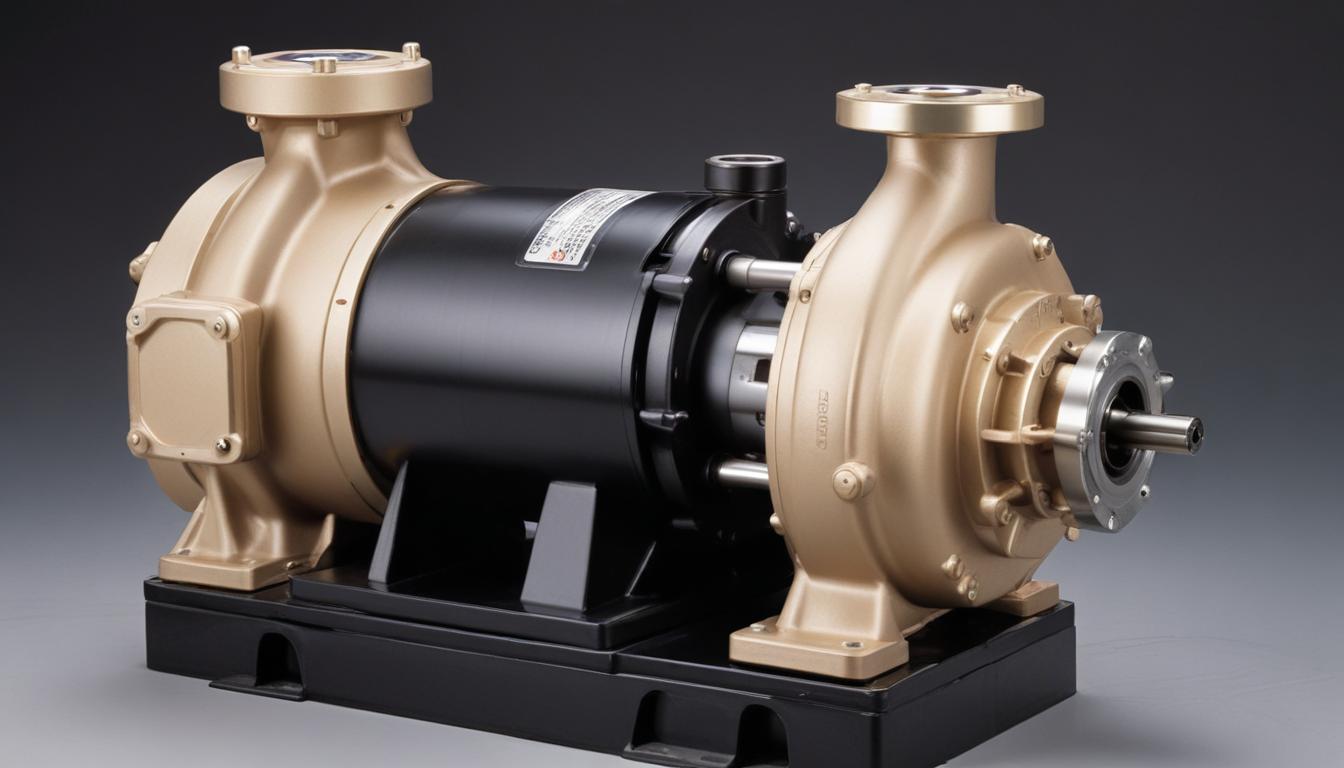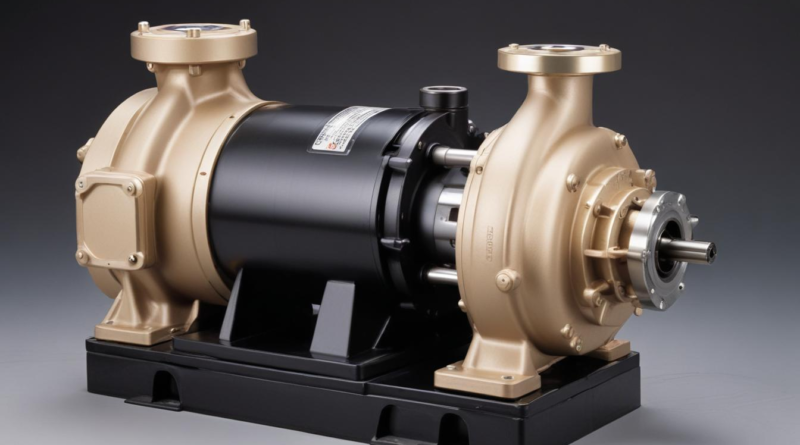exploring magnetic drive pumps
Magnetic drive pumps utilize a unique mechanism that eliminates the need for traditional seals, thereby enhancing their reliability and safety. The core principle revolves around a magnetic coupling that connects the impeller to the motor, allowing power transmission without direct physical contact.
The operation begins with the electric motor, which contains an internal magnet. This magnet generates a rotating magnetic field that extends through a sealed barrier, typically made of a non-magnetic material like glass or ceramic. Attached to this barrier is the impeller, which also houses a corresponding magnet. The interaction between the motor’s magnet and the impeller’s magnet creates a torque that drives the impeller, facilitating the movement of fluids without any leakage.
Key features of this design include:
– Leak-Free Operation: By eliminating mechanical seals, magnetic drive pumps significantly reduce the risk of hazardous fluid leaks.
– Low Maintenance: Fewer moving parts mean there’s less wear and tear, leading to decreased maintenance requirements.
– Enhanced Durability: The absence of seals and other traditional components enhances the overall lifespan of the pump.
The benefits of this operational design are particularly evident in applications involving corrosive or toxic fluids, where traditional seals might fail and pose safety risks. Additionally, the precise control over fluid flow is achieved through the seamless transmission of torque via the magnetic coupling.
A typical magnetic drive pump system comprises the following elements:
| Component | Function |
|---|---|
| Electric Motor | Generates the magnetic field that drives the impeller |
| Magnetic Coupling | Transfers torque from the motor to the impeller without a physical connection |
| Impeller | Moves the fluid through the pump system |
| Sealed Barrier | Prevents fluid leakage while allowing magnetic interaction |
Additionally, the smooth and efficient operation of magnetic drive pumps can be outlined through the following steps:
- The motor initiates rotation, creating a magnetic field.
- The magnetic field interacts with the impeller’s magnet through the sealed barrier.
- This interaction induces the impeller to rotate, moving the fluid.
- The continuous rotation ensures a steady flow of the pumped fluid.
By leveraging electromagnetic principles, magnetic drive pumps offer a robust solution for various industries, ensuring safe and efficient fluid handling. Their innovative design not only enhances performance but also extends the operational life, making them a preferred choice in demanding environments.
key components and design
Magnetic drive pumps are engineered with precision to ensure optimal performance and reliability. The design intricacies of these pumps revolve around several critical components, each playing a pivotal role in the overall functionality. Understanding these elements is essential for appreciating the advanced capabilities of magnetic drive pumps.
Electric Motor:
The electric motor serves as the heart of the pump, responsible for generating the necessary power to drive the system. Typically constructed from high-quality materials to withstand continuous operation, the motor incorporates robust windings and efficient cooling mechanisms to maintain performance under demanding conditions. Advanced designs may include variable frequency drives (VFDs) to allow precise control over the motor speed, enhancing the pump’s adaptability to different applications.
Magnetic Coupling:
This component is essential for the non-contact transmission of torque between the motor and the impeller. Comprising paired magnets arranged in a specific alignment, the magnetic coupling ensures that power is effectively transferred without the need for mechanical seals. The design of the coupling often includes features such as reinforced magnets and optimized spacing to maximize torque transmission while minimizing energy loss. Additionally, materials used in the coupling are selected for their magnetic permeability and resistance to corrosion, ensuring long-term durability.
Impeller:
The impeller is the component responsible for moving the fluid within the pump. Designed with precision-engineered blades, the impeller ensures efficient fluid dynamics, reducing turbulence and enhancing flow rates. Materials chosen for impellers vary based on the application but often include stainless steel, cast iron, or specialized alloys to resist wear and corrosion. The geometry of the impeller can be tailored to specific fluid types and flow requirements, providing versatility across different industrial settings.
Sealed Barrier:
The sealed barrier acts as a safeguard, preventing fluid leakage while allowing the magnetic interaction between the motor and impeller. Typically constructed from non-magnetic materials such as glass-filled epoxy, ceramic, or reinforced plastic, the barrier must maintain structural integrity under varying pressure and temperature conditions. Advanced sealing techniques and materials are employed to ensure that the barrier remains impervious to corrosive or hazardous fluids, thereby enhancing the safety and reliability of the pump system.
Additional Design Features:
- Bearing Systems: High-precision bearings are integrated to support the rotating components, minimizing friction and wear. Sealed bearings are often used to protect against contamination from the pumped fluid.
- Housing and Casing: The pump’s housing is designed to withstand the operational pressures and environmental conditions. It is usually fabricated from corrosion-resistant materials and may include features such as vibration dampening to ensure stable operation.
- Cooling Systems: Efficient cooling mechanisms are incorporated to dissipate heat generated by the motor and other components, preventing overheating and maintaining optimal performance.
- Control Interfaces: Modern magnetic drive pumps are equipped with advanced control systems, including digital displays, sensors, and automated monitoring capabilities, allowing for real-time adjustments and diagnostics.
The interplay between these components is meticulously engineered to deliver the features and benefits associated with magnetic drive pumps. The seamless integration of magnetic coupling and sealed barriers eliminates potential leak points, while the robust design of the motor and impeller ensures consistent and efficient fluid movement. Moreover, the use of high-quality materials and precision manufacturing techniques contributes to the overall durability and longevity of the pump, making it a reliable choice for a wide range of industrial applications.
Design Considerations:
When designing magnetic drive pumps, several factors must be taken into account to ensure optimal performance:
- Fluid Compatibility: Selecting materials that are compatible with the fluid being pumped to prevent corrosion and degradation.
- Flow Rate and Pressure: Designing the impeller and motor specifications to meet the desired flow rate and pressure requirements.
- Environmental Conditions: Ensuring the pump can operate effectively under the specific temperature, pressure, and vibration conditions of the application.
- Maintenance Accessibility: Designing components for ease of access and replacement to facilitate routine maintenance and minimize downtime.
By addressing these considerations, designers can tailor magnetic drive pumps to meet the specific needs of various industries, from chemical processing and pharmaceuticals to water treatment and oil & gas. The thoughtful integration of each component and the strategic design choices collectively enhance the benefits of magnetic drive pumps, positioning them as a superior solution for efficient and reliable fluid handling.
advantages and benefits
Magnetic drive pumps offer a multitude of advantages that make them a preferred choice in various industrial applications. Their innovative design and operational efficiency translate into significant benefits for users, enhancing both performance and cost-effectiveness.
One of the foremost advantages of magnetic drive pumps is their leak-free operation. Traditional pumps rely on mechanical seals, which are potential points of failure and can lead to hazardous leaks, especially when handling corrosive or toxic fluids. By eliminating these seals, magnetic drive pumps drastically reduce the risk of fluid leakage, thereby enhancing workplace safety and minimizing environmental impact.
Low maintenance requirements are another key benefit. The absence of seals and other mechanical components means there are fewer parts that can wear out or require regular replacement. This reduction in maintenance not only lowers operational costs but also minimizes downtime, ensuring continuous and reliable pump performance. Additionally, the streamlined design simplifies maintenance procedures, allowing for quicker and more efficient service when needed.
Enhanced durability is achieved through the robust construction of magnetic drive pumps. Crafted from high-quality, corrosion-resistant materials, these pumps can withstand harsh chemical environments and extreme operating conditions. The magnetic coupling mechanism itself is designed to endure continuous use without significant wear, further extending the pump’s lifespan and reducing the frequency of component replacements.
The energy efficiency of magnetic drive pumps is another significant advantage. Their design ensures optimal power transmission with minimal energy loss, leading to lower electricity consumption compared to traditional pumps. This efficiency not only reduces operational costs but also contributes to a smaller carbon footprint, aligning with sustainability goals.
Operational flexibility is also a notable benefit. Magnetic drive pumps can handle a wide range of fluid viscosities and pressures, making them suitable for diverse applications. Whether it’s handling abrasive materials in mining operations or precise fluid control in pharmaceuticals, these pumps can be tailored to meet specific operational requirements with ease.
Furthermore, magnetic drive pumps offer quiet and vibration-free operation. The absence of direct mechanical contact between the motor and the impeller eliminates noise and reduces vibrations, creating a more comfortable and safer working environment. This feature is particularly advantageous in settings where noise reduction is critical, such as in medical facilities or laboratory environments.
To summarize the benefits, consider the following:
- Safety Enhancement: Leak-free design reduces the risk of hazardous fluid spills.
- Cost Savings: Lower maintenance and energy costs contribute to overall economic efficiency.
- Sustainability: Energy-efficient operation and minimal leakage support environmental initiatives.
- Versatility: Suitable for a wide range of applications across different industries.
- Longevity: Durable materials and design ensure a long operational life.
- User Convenience: Simplified maintenance and reliable performance enhance user experience.
Additionally, the table below highlights a comparison of magnetic drive pumps with traditional mechanical seal pumps:
| Feature | Magnetic Drive Pumps | Traditional Mechanical Seal Pumps |
|---|---|---|
| Leak Prevention | Highly effective due to seal-free design | Dependent on seal integrity |
| Maintenance Frequency | Low | Higher due to seal wear |
| Energy Efficiency | High | Moderate |
| Operational Noise | Low | Higher |
| Durability | Enhanced with robust materials | Limited by mechanical parts |
| Initial Cost | Generally higher | Lower |
While the initial investment for magnetic drive pumps may be higher compared to traditional pumps, the long-term cost benefits often outweigh the upfront expenses. Reduced maintenance needs, lower energy consumption, and extended equipment lifespan contribute to significant savings over time.
In conclusion, the advantages and benefits of magnetic drive pumps make them an excellent investment for industries seeking reliable, efficient, and safe fluid handling solutions. Their advanced design not only meets but often exceeds the performance standards required in demanding operational environments.
common applications
 Magnetic drive pumps are integral to a variety of industries due to their unique properties and reliable performance. Their ability to handle corrosive, toxic, and hazardous fluids makes them particularly valuable in sectors where safety and efficiency are paramount.
Magnetic drive pumps are integral to a variety of industries due to their unique properties and reliable performance. Their ability to handle corrosive, toxic, and hazardous fluids makes them particularly valuable in sectors where safety and efficiency are paramount.
Chemical Processing:
In the chemical industry, magnetic drive pumps are extensively used for the transfer of aggressive chemicals and solvents. Their seal-free design prevents leaks, ensuring the containment of hazardous substances and protecting both personnel and the environment. Additionally, the compatibility of materials used in these pumps with a wide range of chemicals enhances their applicability in diverse chemical processes.
Pharmaceuticals:
The pharmaceutical sector demands high levels of purity and precision. Magnetic drive pumps facilitate the handling of sensitive fluids without contamination, thanks to their enclosed design. Their ability to maintain sterile conditions is crucial for processes such as drug formulation, where contamination can compromise product quality and safety.
Water and Wastewater Treatment:
In water and wastewater treatment facilities, magnetic drive pumps play a critical role in the circulation and treatment processes. Their reliability and low maintenance requirements ensure continuous operation, which is essential for maintaining water quality standards. Additionally, their energy-efficient operation contributes to the overall cost-effectiveness of treatment plants.
Oil and Gas:
The oil and gas industry benefits from magnetic drive pumps in applications such as slurry handling, where abrasive materials are common. The robust construction of these pumps, combined with their ability to handle high-viscosity fluids, makes them suitable for challenging environments. Furthermore, their leak-free operation is crucial in preventing the release of hydrocarbons, thereby enhancing environmental safety.
Food and Beverage:
Ensuring hygiene and preventing contamination are critical in the food and beverage industry. Magnetic drive pumps cater to these needs by providing a sanitary solution for fluid transfer. Their easy cleaning and maintenance further support compliance with stringent health and safety regulations.
Biotechnology:
In biotechnology, precise fluid control is essential for processes such as cell cultivation and fermentation. Magnetic drive pumps offer the necessary control and reliability, enabling the efficient handling of biological fluids without introducing contaminants. Their ability to operate quietly and with minimal vibration also supports sensitive biological processes.
Power Generation:
Power plants utilize magnetic drive pumps for the circulation of cooling water and other fluids essential for maintaining operational efficiency. The durability and reliability of these pumps ensure uninterrupted power generation, even under demanding conditions. Their energy-efficient performance also contributes to the overall efficiency of power plants.
Mining:
The mining industry often involves the transport of slurry and other abrasive materials. Magnetic drive pumps are well-suited for these applications due to their robust design and ability to handle high-solid-content fluids. Their resistance to wear and corrosion extends their service life, reducing the need for frequent replacements and maintenance.
HVAC Systems:
In heating, ventilation, and air conditioning (HVAC) systems, magnetic drive pumps are used for the circulation of coolant and other fluids. Their silent operation and energy efficiency make them ideal for maintaining comfortable and controlled indoor environments while minimizing energy consumption.
The table below illustrates the diverse applications of magnetic drive pumps across different industries:
| Industry | Common Applications | Key Benefits |
|---|---|---|
| Chemical Processing | Transfer of aggressive chemicals, solvent handling | Leak prevention, chemical compatibility |
| Pharmaceuticals | Drug formulation, sterile fluid handling | Contamination-free operation, precision control |
| Water Treatment | Fluid circulation, treatment processes | Reliability, energy efficiency |
| Oil and Gas | Slurry handling, hydrocarbon transfer | Robustness, leak-free operation |
| Food and Beverage | Sanitary fluid transfer, cleaning processes | Hygienic design, easy maintenance |
| Biotechnology | Cell cultivation, fermentation | Precise control, contamination prevention |
| Power Generation | Cooling water circulation, fluid management | Durability, energy efficiency |
| Mining | Slurry transport, abrasive material handling | Wear resistance, extended lifespan |
| HVAC Systems | Coolant circulation, fluid management | Silent operation, energy savings |
Furthermore, magnetic drive pumps are increasingly finding applications in emerging fields such as renewable energy systems and advanced manufacturing. Their adaptability and the continuous advancements in pump technology ensure that they remain at the forefront of fluid handling solutions. By providing a combination of safety, efficiency, and reliability, magnetic drive pumps support the operational demands of modern industries, helping them achieve higher performance standards and sustainability goals.
In summary, the versatility of magnetic drive pumps allows them to meet the stringent requirements of various sectors, making them a critical component in ensuring efficient and safe fluid management across a wide spectrum of applications.
maintenance and troubleshooting
Regular maintenance is crucial to ensure the optimal performance and longevity of magnetic drive pumps. By adhering to a systematic maintenance schedule, operators can prevent unexpected failures, minimize downtime, and extend the service life of the equipment. Effective maintenance practices involve both routine inspections and proactive troubleshooting to address potential issues before they escalate.
Routine Maintenance Procedures:
- Visual Inspections: Conduct regular visual checks for signs of wear, corrosion, or damage to the pump’s exterior components. Look for any indications of fluid leaks around the housing and sealed barrier.
- Magnetic Coupling Alignment: Ensure that the magnetic coupling remains properly aligned. Misalignment can lead to inefficient torque transfer and increased wear on the magnetic components.
- Impeller Inspection: Examine the impeller for signs of erosion, corrosion, or debris accumulation. Clean the impeller as necessary to maintain optimal fluid flow and prevent blockages.
- Sealed Barrier Integrity: Verify the integrity of the sealed barrier. Check for any cracks or breaches that could compromise the leak-free operation of the pump.
- Lubrication of Bearings: Although magnetic drive pumps typically have low maintenance requirements, it is essential to check and lubricate the bearings periodically to reduce friction and prevent premature wear.
- Electrical Connections: Inspect all electrical connections for signs of corrosion, looseness, or damage. Ensure that wiring is intact and that there are no exposed conductors.
- Cooling System Maintenance: If the pump is equipped with a cooling system, regularly check the coolant levels and ensure that the cooling components are functioning correctly to prevent overheating.
Common Issues and Troubleshooting:
Despite their robust design, magnetic drive pumps can encounter specific issues that necessitate troubleshooting. Understanding these common problems and their solutions is essential for maintaining uninterrupted pump operation.
| Issue | Possible Causes | Troubleshooting Steps |
|---|---|---|
| Reduced Flow Rate |
|
|
| Excessive Noise or Vibration |
|
|
| Overheating |
|
|
| Magnetic Coupling Slippage |
|
|
| Seal Barrier Breach |
|
|
Best Practices for Maintenance and Troubleshooting:
Adopting best practices in maintenance and troubleshooting can significantly enhance the reliability of magnetic drive pumps:
- Scheduled Maintenance: Establish and adhere to a regular maintenance schedule based on the manufacturer’s recommendations and the pump’s operational demands.
- Training: Ensure that maintenance personnel are adequately trained in the specific requirements and procedures for magnetic drive pumps.
- Documentation: Keep detailed records of all maintenance activities, inspections, and repairs. This documentation aids in tracking the pump’s performance and identifying recurring issues.
- Use of Genuine Parts: Utilize manufacturer-approved replacement parts to ensure compatibility and maintain the integrity of the pump’s features and benefits.
- Environmental Control: Maintain appropriate environmental conditions around the pump to prevent excessive exposure to corrosive agents, extreme temperatures, and physical stress.
- Monitoring Systems: Implement monitoring systems to continuously track the pump’s performance parameters, enabling early detection of anomalies and timely intervention.
By integrating these maintenance and troubleshooting strategies, operators can maximize the efficiency and durability of magnetic drive pumps. Proactive maintenance not only safeguards the pump’s functionality but also preserves the critical features and benefits that make magnetic drive pumps a superior choice for various industrial applications.




